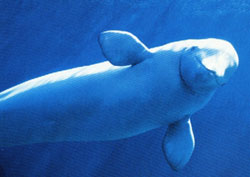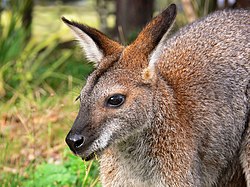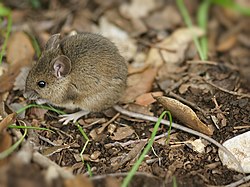List of mammals of Great Britain
This is a list of mammals of Great Britain.
The Great Britain mammal fauna is impoverished compared with that of continental Europe. This is because there was only a short time between the last ice age and the flooding of the land bridge between Britain and the rest of Europe. The list only has land species which crossed before the creation of the English Channel, and those later brought in by humans.
Native (indigenous) species have three possible definitions:
- a species which colonised the islands during the glacial retreat at the end of the last ice age (c.9500 years ago);
- a species that was present when the English Channel was created (c.8000 years ago);
- or, a species that was present in prehistory.
This list includes mammals from the small islands around Great Britain and the Channel Islands. There are no endemic mammal species in Great Britain, although four distinct subspecies of rodents have arisen on small islands.
Rodentia
Rodents make up the largest order of mammals, with over 40 percent of mammalian species. They have two incisors in the upper and lower jaw which grow continuously and must be kept short by gnawing. Most rodents are small though the coypu (once introduced to Great Britain, but subsequently eradicated) can weigh up to 9 kg (15.5 lb).
Family: Muridae (rats, mice and relatives)
Family: Gliridae (dormice)
- Edible dormouse Glis glis – Introduced
Family: Sciuridae (squirrels)
- Grey squirrel Sciurus carolinensis – Introduced
Lagomorpha
The lagomorphs comprise two families, Leporidae (hares and rabbits), and Ochotonidae (pikas). Though they resemble rodents, and were classified as a superfamily in that order until the early 20th century, they have since been put in a separate order. They differ from rodents in a number of physical characteristics, such as having four incisors in the upper jaw rather than two.
Family: Leporidae (hares and rabbits)
- Mountain hare Lepus timidus
- Irish hare L. t. hibernicus – Introduced Isle of Mull
- European hare L. europaeus – Possibly introduced
- European rabbit Oryctolagus cuniculus – Introduced
Hedgehogs
Superorder: Laurasiatheria Order: Erinaceomorpha
The order Erinaceomorpha contains a single family, Erinaceidae, which comprise the hedgehogs and gymnures. The hedgehogs are easily recognised by their spines while gymnures look more like large rats.
- European hedgehog Erinaceus europaeus
Shrews and moles
Superorder: Laurasiatheria Order: Soricomorpha
The "shrew-forms" are insectivorous mammals. The shrews and soledons closely resemble mice while the moles are stout-bodied burrowers.
- Greater white-toothed shrew Crocidura russula – Likely introduced, Channel Islands only
- Lesser white-toothed shrew C. suaveolens – Likely introduced, Isles of Scilly and Channel Islands only
Bats
Superorder: Laurasiatheria Order: Chiroptera
The bats' most distinguishing feature is that their forelimbs are developed as wings, making them the only mammals in the world naturally capable of flight. Bat species account for about 20% of all mammals.
- Greater horseshoe bat Rhinolophus ferrumequinum
- Lesser horseshoe bat R. hipposideros
- Greater mouse-eared bat Myotis myotis – Vagrant
- Whiskered bat M. mystacinus
- Brandt's bat M. brandti
- Natterer's bat M. nattereri
- Bechstein's bat M. bechsteini
- Daubenton's bat M. daubentoni
- Geoffroy's bat M. emarginatus[1]
- Alcathoe bat M. alcathoe[2]
- Parti-coloured bat Vespertilio murinus – Vagrant
- Serotine Eptesicus serotinus
- Northern bat E. nilssoni – Vagrant
- Common noctule Nyctalus noctula
- Leisler's bat or lesser noctule N. leisleri
- Hoary bat Lasiurus cinereus – Vagrant
- Common pipistrelle Pipistrellus pipistrellus
- Soprano pipistrelle P. pygmaeus
- Nathusius pipistrelle P. nathusii
- Kuhl's pipistrelle P. kuhlii
- Barbastelle Barbastella barbastellus
- Brown long-eared bat Plecotus auritus
- Grey long-eared bat P. austriacus
Even-toed ungulates
Superorder: Laurasiatheria Order: Artiodactyla
The even-toed ungulates are ungulates whose weight is borne about equally by the third and fourth toes, rather than mostly or entirely by the third as in perissodactyls. There are about 220 artiodactyl species, including many that are of great economic importance to humans.
- Sika deer C. nippon – Introduced
- Fallow deer Dama dama - Introduced
- Reeves's muntjac Muntiacus reevesi – Introduced
- Water deer Hydropotes inermis – Introduced
Odd-toed ungulates
Superorder: Laurasiatheria Order: Perissodactyla
The odd-toed ungulates are browsing and grazing mammals. They are usually large to very large, and have relatively simple stomachs and a large middle toe.
- Feral horse Equus ferus caballus - Exmoor pony, Dartmoor pony
Carnivora
Superorder: Laurasiatheria Order: Carnivora
- American mink M. vison – Introduced
Order: Cetacea
Whales


The order Cetacea includes whales, dolphins and porpoises. They are the mammals most fully adapted to aquatic life with a spindle-shaped nearly hairless body, protected by a thick layer of blubber, and forelimbs and tail modified to provide propulsion underwater.
- Suborder: Mysticeti
- Family: Balaenidae
- Genus: Eubalaena
- North Atlantic right whale Eubalaena glacialis EN
- Genus: Eubalaena
- Family: Balaenopteridae
- Subfamily: Balaenopterinae
- Genus: Balaenoptera
- Fin whale Balaenoptera physalis
- Minke whale Balaenoptera acutorostrata LR/NT
- Sei whale Balaenoptera borealis
- Blue whale Balaenoptera musculus [3]
- Genus: Megaptera
- Humpback whale Megaptera novaeangliae
- Genus: Balaenoptera
- Subfamily: Balaenopterinae
- Family: Balaenidae
- Suborder: Odontoceti
- Superfamily: Platanistoidea
- Family: Monodontidae
- Genus: Delphinapterus
- Beluga Delphinapterus leucas VU
- Genus: Delphinapterus
- Family: Phocoenidae
- Genus: Phocoena
- Harbour porpoise Phocoena phocoena VU
- Genus: Phocoena
- Family: Physeteridae
- Genus: Physeter
- Sperm whale Physeter macrocephalus VU
- Genus: Physeter
- Family: Kogiidae
- Genus: Kogia
- Pygmy sperm whale Kogia breviceps LR/LC
- Genus: Kogia
- Family: Ziphidae
- Genus: Ziphius
- Cuvier's beaked whale Ziphius cavirostris DD
- Genus: Ziphius
- Subfamily: Hyperoodontidae
- Genus: Hyperoodon
- Northern bottlenose whale Hyperoodon ampullatus LR/CD
- Genus: Mesoplodon
- Sowerby's beaked whale Mesoplodon bidens DD
- Gervais' beaked whale Mesoplodon europaeus DD
- True's beaked whale Mesoplodon mirus DD
- Genus: Pseudorca
- False killer whale Pseudorca crassidens
- Genus: Hyperoodon
- Family: Monodontidae
- Superfamily: Platanistoidea
Dolphins
- Family: Delphinidae (marine dolphins)
- Genus: Delphis
- Short-beaked common dolphin Delphinus delphis
- Genus: Tursiops
- Common bottlenose dolphin Tursiops truncatus DD
- Genus: Stenella
- Striped dolphin Stenella coeruleoalba LR/cd
- Genus: Lagenorhynchus
- Atlantic white-sided dolphin Lagenorhynchus acutus LR/LC
- White-beaked dolphin Lagenorhynchus albirostris LR/LC
- Genus: Grampus
- Risso's dolphin Grampus griseus DD
- Genus: Delphis
- Family: Delphinidae (marine dolphins)
Introduced animals
Diprotodontia
Though most marsupials make up a great part of the fauna in the Australian region, the red-necked wallaby has been introduced and a feral population is currently breeding on the island of Inchconnachan, and at Loch Lomond in Argyll and Bute, Scotland. A smaller group is present on the Isle of Man, and the species is locally extinct in the Peak District, in Cumbria, and at Ashdown Forest in East Sussex.
Family: Macropodidae (kangaroos, wallabies, and kin)
- Red-necked wallaby Macropus rufogriseus - Introduced
List Of Mammals Of Great Britain Media
References
- ↑ "Geoffroy's bat discovered in UK for first time". BBC News. 14 September 2012. Retrieved 14 October 2012.
- ↑ "Bat species discovered for the first time in UK". University of Leeds. 20 April 2010. Archived from the original on 7 April 2013. Retrieved 15 October 2012.
- ↑ "Blue Whale – Balaenoptera musculus". ORCA. Retrieved 14 October 2012.
Other websites
- A Review of British Mammals, 1995 Archived 2004-09-13 at the Wayback Machine (PDF format)
- The Mammal Society: Mammals of the British Isles Archived 2011-10-19 at the Wayback Machine
- Discuss UK wildlife Archived 2020-02-14 at the Wayback Machine











